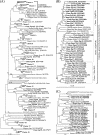Identification and ecophysiological characterization of epiphytic protein-hydrolyzing saprospiraceae ("Candidatus Epiflobacter" spp.) in activated sludge
- PMID: 18263744
- PMCID: PMC2292613
- DOI: 10.1128/AEM.02502-07
Identification and ecophysiological characterization of epiphytic protein-hydrolyzing saprospiraceae ("Candidatus Epiflobacter" spp.) in activated sludge
Abstract
The identity and ecophysiology of a group of uncultured protein-hydrolyzing epiphytic rods attached to filamentous bacteria in activated sludge from nutrient removal plants were investigated by using the full-cycle rRNA approach combined with microautoradiography and histochemical staining. The epiphytic group consists of three closely related clusters, each containing 11 to 16 clones. The closest related cultured isolate is the type strain Haliscomenobacter hydrossis (ATCC 27775) (<87% similarity) in the family Saprospiraceae of the phylum Bacteroidetes. Oligonucleotide probes at different hierarchical levels were designed for each cluster and used for ecophysiological studies. All three clusters behaved similarly in their physiology and were specialized in protein hydrolysis and used amino acids as energy and carbon sources. They were not involved in denitrification. No storage of polyphosphate and polyhydroxyalkanoates was found. They all colonized probe-defined filamentous bacteria belonging to the phyla Chloroflexi, Proteobacteria, and candidate phylum TM7, with the exception of cluster 1, which did not colonize TM7 filaments. The three epiphytic clusters were all widespread in domestic and industrial wastewater treatment plants with or without biological phosphorus removal, constituting, in total, up to 9% of the bacterial biovolume. A new genus, "Candidatus Epiflobacter," is proposed for this epiphytic group in activated-sludge treatment plants, where it presumably plays an important role in protein degradation.
Figures


References
-
- Björnsson, L., P. Hugenholtz, G. W. Tyson, and L. L. Blackall. 2002. Filamentous Chloroflexi (green non-sulfur bacteria) are abundant in wastewater treatment processes with biological nutrient removal. Microbiology 148:2309-2318. - PubMed
-
- Brosius, J., T. J. Dull, D. D. Sleeter, and H. F. Noller. 1981. Gene organization and primary structure of a ribosomal-RNA operon from Escherichia coli. J. Mol. Biol. 148:107-127. - PubMed
Publication types
MeSH terms
Substances
Associated data
- Actions
- Actions
- Actions
- Actions
- Actions
- Actions
- Actions
- Actions
- Actions
- Actions
- Actions
- Actions
- Actions
- Actions
- Actions
- Actions
- Actions
- Actions
- Actions
- Actions
- Actions
- Actions
- Actions
- Actions
- Actions
- Actions
- Actions
- Actions
- Actions
- Actions
- Actions
- Actions
- Actions
- Actions
- Actions
- Actions
- Actions
- Actions
- Actions
- Actions
- Actions
- Actions
- Actions
- Actions
- Actions
- Actions
- Actions
- Actions
- Actions
- Actions
- Actions
- Actions
- Actions
- Actions
- Actions
- Actions
- Actions
- Actions
- Actions
- Actions
- Actions
- Actions
- Actions
- Actions
- Actions
- Actions
- Actions
- Actions
- Actions
- Actions
- Actions
- Actions
- Actions
- Actions
- Actions
- Actions
- Actions
- Actions
- Actions
- Actions
- Actions
- Actions
- Actions
- Actions
- Actions
- Actions
- Actions
- Actions
- Actions
- Actions
- Actions
- Actions
- Actions
- Actions
- Actions
- Actions
- Actions
- Actions
- Actions
- Actions
- Actions
- Actions
- Actions
- Actions
- Actions
- Actions
- Actions
- Actions
- Actions
- Actions
- Actions
- Actions
- Actions
- Actions
- Actions
- Actions
- Actions
- Actions
- Actions
- Actions
- Actions
- Actions
- Actions
- Actions
- Actions
- Actions
- Actions
- Actions
- Actions
- Actions
LinkOut - more resources
Full Text Sources
Molecular Biology Databases
Miscellaneous

